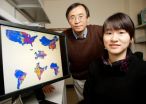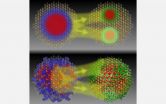(Press-News.org) Many of the mapping and monitoring efforts associated with REDD focus on the big picture of carbon stock and of deforestation trends throughout the tropics. A research expedition just underway, led by scientists at the Woods Hole Research Center, is focusing on the third piece necessary to inform a global REDD mechanism – namely, how do people use the land? Through a series of participatory mapping workshops with indigenous peoples in the Congo Basin, scientists and participants are discussing land tenure, forest inventory techniques, and baselines that could help secure lands for local populations. Outcomes will include training in the use of GPS for mapping and a report from interviews done in the field.
Nadine Laporte, Glenn Bush, and Scott Goetz are scientists at WHRC and are leading this effort. Their itinerary began in Kinshasa, on March 14, and continues to Gemena, Bikoro, and Mbandaka. The trip concludes on April 1.
This expedition is part of the capacity building component of a three-year grant to the Center from The Gordon and Betty Moore Foundation, google.org, and The David and Lucile Packard Foundation.
Glenn K. Bush, Ph.D., is an environmental economist who specializes in welfare economics, resource valuation, and environmental cost-benefit analysis. His work has focused on quantitative valuation of forest conservation strategies for forest-adjacent households, as well as the microeconomic and social determinants of forest conservation. He is currently concerned with developing and testing combined econometric and spatial models on the drivers and determinants of land cover change. Dr. Bush has previously worked in Africa and in Central and Southeast Asia as a researcher, project manager, and consultant on natural resource management and conservation projects in the public and private sector. He has held positions with the UK Government Department for International Development, the Wildlife Conservation Society, and the Dian Fossey Gorilla Fund International. He obtained his M.Sc. in Agricultural Economics from the University of London, Wye College, and his Ph.D. in Economics from the University of Stirling, UK.
Scott Goetz, Ph.D., is a Senior Scientist at the Woods Hole Research Center and works on the application of satellite imagery to analyses of environmental change, including monitoring and modeling links between land use change, forest productivity, biodiversity, climate, and human health. Before joining the WHRC, he was on the faculty at the University of Maryland, where he maintains an adjunct associate professor appointment, and was a research scientist at NASA's Goddard Space Flight Center. He received his Ph.D. from the University of Maryland and recently completed a Fulbright-sponsored visiting scientist appointment in Toulouse, France.
Nadine T. Laporte, Ph.D., is a biologist whose research centers on the applications of satellite imagery to tropical forest ecosystems, including vegetation & carbon mapping, land-use change, deforestation causes and consequences on carbon and biodiversity. She has been involved in numerous environmental projects in Central Africa over the past ten years, working with in-country scientists, foresters, and international conservation organizations to develop integrated forest monitoring systems and promote forest conservation. She received her doctorate in tropical biogeography from l'Université Paul Sabatier in Toulouse, France.
###The team is chronicling their expedition in a Field Notes Journal, with near-daily updates. For more information, please visit www.whrc.org/education/capacitybldg.html
The Woods Hole Research Center addresses the great issues for a healthy planet through science, education, and policy. Center staff combine remote sensing with field research to study, model, map and monitor Earth's land surface, and advance the knowledge gained to define solutions for sustainable well being. Current core areas for the Center include climate change, land use, and water.
Participatory mapping workshops underway in Congo
Woods Hole Research Center scientists leading collaborations
2011-03-26
ELSE PRESS RELEASES FROM THIS DATE:
WARHEADS Takes It Off for the St. Baldrick's Foundation
2011-03-26
WARHEADS (www.warheads.com), the authentic, edgy and kid favorite sour candy, has partnered for the second year in a row with the leading organization committed to funding the most promising research to find cures for childhood cancers and give survivors long and healthy lives - the St. Baldrick's Foundation.
The St. Baldrick's Foundation (www.stbaldricks.org), started in 2000, hosts an annual event around St. Patrick's Day, in which volunteers shave their heads in solidarity of children that have cancer. Over $95 million in donations in 24 countries and all 50 states ...
Asthma drug could help control or treat Alzheimer's disease
2011-03-26
A drug used to treat asthma has been shown to help reduce the formation of amyloid beta, a peptide in the brain that is implicated in the development of Alzheimer's disease, according to researchers at Temple University's School of Medicine.
The researchers published their findings, "Pharmacologic Blockade of 5-Lipoxygenase
Improves the Amyloidotic Phenotype of an AD Transgenic Mouse Model," in the American Journal of Pathology.
In previous studies, the Temple researchers discovered that 5-lipoxygenase, an enzyme long known to exist in the brain, controls the activation ...
Researchers unlock new secret to how smells are detected
2011-03-26
AURORA, Colo. (March 25, 2011) – Researchers seeking to unravel the most ancient yet least understood of the five senses – smell – have discovered a previously unknown step in how odors are detected and processed by the brain.
The four year study, focusing on how mice respond to odors, showed that smells are picked up by the olfactory bulb – the first stop on the way to the brain – then sent to the olfactory cortex for further analysis.
But scientists discovered something else – a dialogue between the bulb and the cortex conducted by rapidly firing nerve cells.
"It ...
Study shows living at high altitude reduces risk of dying from heart disease
2011-03-26
AURORA, Colo. (March 25, 2011) – In one of the most comprehensive studies of its kind, researchers at the University of Colorado School of Medicine in partnership with the Harvard School of Global Health have found that people living at higher altitudes have a lower chance of dying from ischemic heart disease and tend to live longer than others.
"If living in a lower oxygen environment such as in our Colorado mountains helps reduce the risk of dying from heart disease it could help us develop new clinical treatments for those conditions," said Benjamin Honigman, MD, ...
Some outcomes of the evolutionary race buck conventional wisdom
2011-03-26
In some cases, less fit organisms may out-survive their in-shape counterparts, according to a study reported in the March 18 issue of Science. The finding surprised researchers who assumed less fit organisms would be the eventual losers in evolution's fight for survival.
Microbial Ecology professor Richard Lenski of Michigan State University conducted the study with funding from the National Science Foundation (NSF).
Using easy-to-understand terms in a revealing video accompanying this release, Lenski describes his results and explains why his study is so unique.
"This ...
Study predicts large regional changes in farmland area
2011-03-26
CHAMPAIGN, Ill. — The effects of climate change and population growth on agricultural land area vary from region to region, according to a new study by University of Illinois researchers.
Regions with relative high latitudes – China, Russia and the U.S. – could see a significant increase in arable land in coming years, but Africa, Europe and India and South America could lose land area.
Civil and environmental engineering professor Ximing Cai and graduate student Xiao Zhang published their findings in the journal Environmental Research Letters.
While most other studies ...
School energy audits find millions in potential energy savings
2011-03-26
A two-year energy audit of Hamilton schools has identified energy conservation measures that could reduce their energy costs by almost $2.4 million annually. The audit was conducted by engineering faculty and students at McMaster University
The measures, presented today to officials from the Hamilton-Wentworth District School Board and the Hamilton-Wentworth Catholic District School Board, range from recaulking windows, adding insulation and using more efficient lighting to new investments in advanced heat recovery systems and boilers, and solar and wind generating systems.
"We ...
Research finds 'dispense as written' prescriptions may add $7.7 billion to annual health care costs
2011-03-26
March 25, 2011 – Approximately five percent of prescriptions submitted by CVS Caremark Pharmacy Benefit Management (PBM) members in a 30-day period during 2009 included a "dispense as written" (DAW) designation. This practice – whereby doctors or patients demand the dispensing of a specific brand-name drug and not a generic alternative – costs the health care system up to $7.7 billion annually, according to a new study by researchers at Harvard University, Brigham and Women's Hospital and CVS Caremark. Moreover, these requests reduce the likelihood that patients actually ...
Study finds weight training safe for pregnant women
2011-03-26
Despite decades of doctors' reluctance to recommend weight training to pregnant women, a new University of Georgia study has found that a supervised, low-to-moderate intensity program is safe and beneficial.
The research, published in the current edition of the Journal of Physical Activity and Health, measured progression in the amount of weight used, changes in resting blood pressure and potential adverse side effects in 32 pregnant women over a 12-week period. After a total of 618 exercise sessions, none of the pregnant women in the study experienced a musculoskeletal ...
Size matters: Smaller particles could make solar panels more efficient
2011-03-26
Studies done by Mark Lusk and colleagues at the Colorado School of Mines could significantly improve the efficiency of solar cells. Their latest work describes how the size of light-absorbing particles--quantum dots--affects the particles' ability to transfer energy to electrons to generate electricity.
The results are published in the April issue of the journal ACS Nano.
The advance provides evidence to support a controversial idea, called multiple-exciton generation (MEG), which theorizes that it is possible for an electron that has absorbed light energy, called an ...
LAST 30 PRESS RELEASES:
New report outlines science priorities for human Mars exploration
Want to curb cannabis-related crashes? Don’t forget older adults, study finds
Expectant management vs medication for patent ductus arteriosus in preterm infants
Pew funds 7 new biomedical research collaborations
The ERC selects 349 mid-career researchers for €728 million in Consolidator Grants
ERC Consolidator Grant awarded to CISPA researcher Rayna Dimitrova
Antimicrobial effects of Syzygium aromaticum and Salvadora persica against common peri-implantitis pathogens in vitro
EVs pose no greater risk to pedestrians than conventional vehicles
Modeling microplastic accumulation under the ocean surface
Pompeii offers insights into ancient Roman building technology
University of Utah engineers give a bionic hand a mind of its own
Transient and long-term risks of common physical activities in people with low back pain
Health care contact days in older adults with metastatic cancer
Brain resilience science reshapes psychiatry from treating illness to building strength
An assessment of the antidepressant potential of deramciclane in two animal tests
Pitt and UPMC study finds epigenetic signature of pediatric traumatic brain injury, paves way for precision recovery tools
Brain discovery opens door to earlier detection of metabolic syndrome in women
SwRI-led study provides insight into oscillations in solar flares
Announcing the third cohort of the Hevolution/AFAR new investigator awards in aging biology and geroscience research
GeoFlame VISION: Using AI and satellite imagery to predict future wildfire risk
Nationwide study suggests that water treatment methods may impact the risk of legionnaires’ disease
Oyster larvae on drugs move slowly and are stressed
Targeting a specific brain circuit may help prevent opioid relapse, WSU study finds
Tec-Dara combination offers substantial improvement over standard second-line therapies for relapsed or refractory multiple myeloma
Improving treatment for an autoimmune bleeding condition
Drug reduced need for blood transfusions during hospitalization for non-cardiac surgery
Novel agent ianalumab added to standard therapy extends time to treatment failure in patients with previously treated immune thrombocytopenia
Pirtobrutinib outperforms bendamustine plus rituximab for previously untreated CLL/SLL
Online tracking and privacy on hospital websites
A freely available tool to document wartime destruction
[Press-News.org] Participatory mapping workshops underway in CongoWoods Hole Research Center scientists leading collaborations



